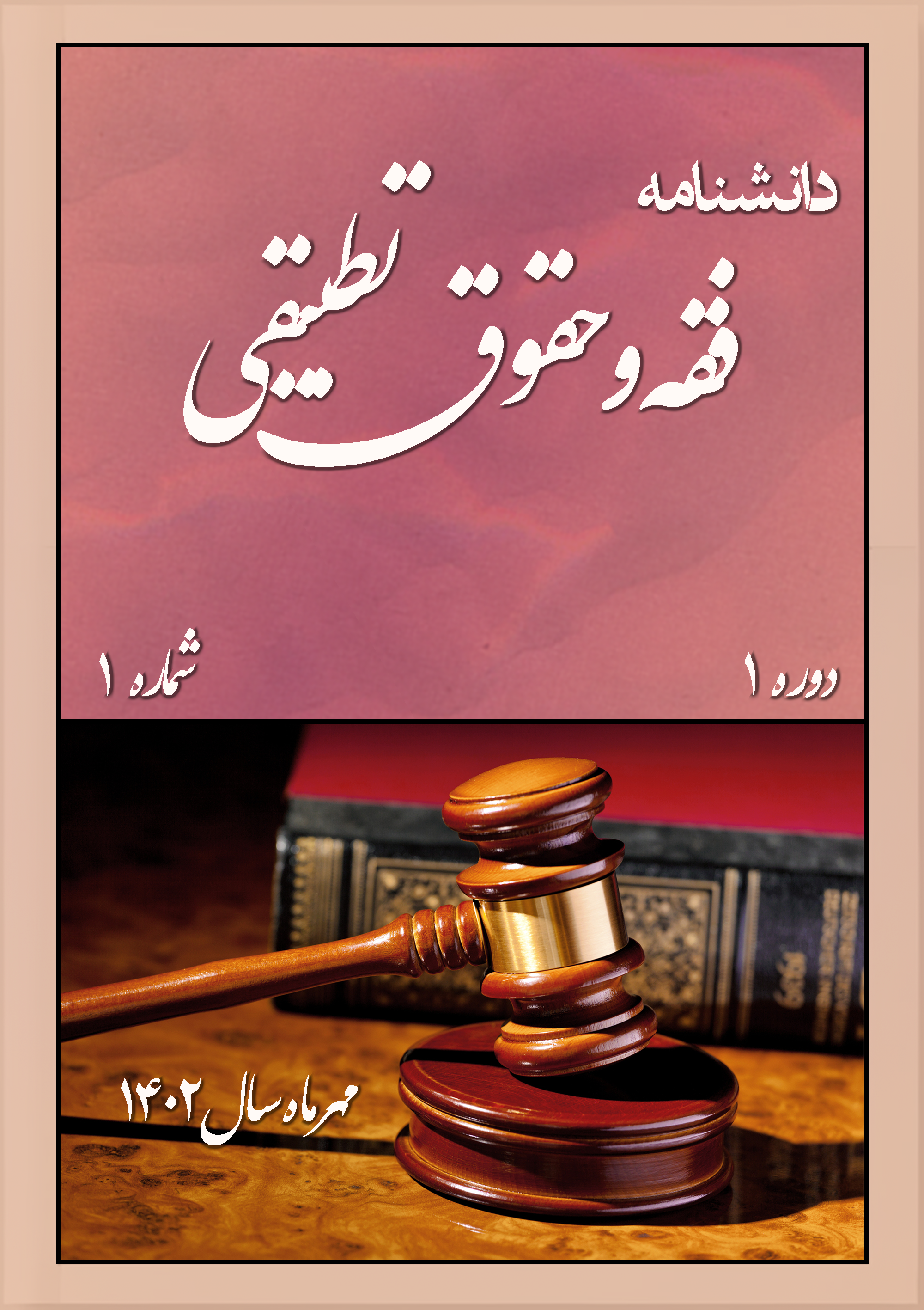مبانی زیستی و عصبشناختی رفتار خشونتآمیز در حقوق کیفری ایران
کلمات کلیدی:
مبانی زیستی , مبانی عصبشناختی, رفتار خشونتآمیز , حقوق کیفری ایرانچکیده
خشونت یکی از چالشبرانگیزترین معضلات جوامع معاصر، اغلب ریشه در ترکیبی از اختلالات روانی، نارساییهای عصبی، نوسانات هورمونی و فشارهای اجتماعی دارد. از سویی، نظامهای کیفری سنتی عمدتاً واکنشی و تنبیهی عمل کردهاند؛ از سوی دیگر، یافتههای نوین در علوم اعصاب، روانشناسی ، افقهای جدیدی برای پیشگیری زیستی و رفتاری از بروز خشونت گشودهاند. این پژوهش با رویکردی توصیفی-تحلیلی و با بهرهگیری از ادبیات نظری میانرشتهای، به بررسی جامع مبانی زیستی و عصبشناختی رفتار خشونتآمیز پرداخته است. در این مطالعه، بر اساس نظریههای پیشگیری رشدمدار، اجتماعی، موقعیتی و روانزیستی، نشان داده میشود که خشونت رفتاری صرفاً پدیدهای اجتماعی یا تربیتی نیست، بلکه ریشههای عمیق زیستی، عصبی و هورمونی دارد که باید در رویکردهای مدرن جرمشناسی مورد توجه قرار گیرند. پیوند ورزش با ساختارهای مغزی، سیستمهای نوروترنسمیتر و ترشحات هورمونی، همراه با نقش آن در تعدیل روانی و اجتماعی فرد، جایگاهی کلیدی در پیشگیری از خشونت مییابد. از سوی دیگر، ورود مفاهیم حقوق عصبشناختی به عرصه حقوق کیفری نوین، بستری را فراهم میآورد که در آن دادههای علمی به تصمیمگیری عادلانهتر و مداخلات هدفمندتر کمک میکنند. این چارچوب میانرشتهای، پایهای علمی برای توسعه سیاستهای عدالت کیفری انسانمحور و اثربخشتر ایجاد میکند.
دانلودها
مراجع
Aharoni, R. (2013). Foundation for a general strain theory of crime and delinquency. In Crime, Inequality and the State (Vol. 30, pp. 47-88). https://doi.org/10.4324/9781003060581-23
Archer, J. (2006). Testosterone and human aggression: An evaluation of the challenge hypothesis. Neuroscience & Biobehavioral Reviews, 30(3), 319-345. https://doi.org/10.1016/j.neubiorev.2004.12.007
Batty, G. D., Kivimäki, M., & Bell, S. (2018). Physical activity and violence prevention: Epidemiological evidence. British Journal of Sports Medicine, 52(3), 176-178.
Beccaria, C. (1996). On Crimes and Punishments. Macmillan.
Bentham, J. (1789). An Introduction to the Principles of Morals and Legislation. https://doi.org/10.1093/oseo/instance.00077240
Blair, R. J. R. (2001). Neurocognitive models of aggression, the antisocial personality disorders, and psychopathy. Journal of neurology, neurosurgery & psychiatry, 71(6), 727-731. https://doi.org/10.1136/jnnp.71.6.727
Blair, R. J. R. (2010). Neuroimaging of psychopathy and antisocial behavior: A targeted review. Current psychiatry reports, 12(1), 76-82. https://doi.org/10.1007/s11920-009-0086-8
Boyle, L. M., Sheng, W., Leroy, F., Sahai, R., Irfan, S., Lee, H.-J., Villegas, A., Young, W. S., & Siegelbaum, S. A. (2024). The ventral CA2 region of the hippocampus and its differential contributions to social memory and social aggression. bioRxiv. https://doi.org/10.1101/2024.06.07.597964
Brower, M. C., & Price, B. H. (2001). Neuropsychiatry of frontal lobe dysfunction in violent and criminal behavior: a critical review. American Journal of Psychiatry, 158(10), 720-726. https://doi.org/10.1176/appi.ajp.158.10.1783
Bufkin, J., & Luttrell, V. R. (2005). Neuroimaging studies of aggressive and violent behavior: current findings and implications for criminology and criminal justice. Trauma, Violence, & Abuse, 6(2), 176-191. https://doi.org/10.1177/1524838005275089
Chaouloff, F. (1989). Physical exercise and brain monoamines: A review. Acta Physiologica Scandinavica, 137(1), 1-13. https://doi.org/10.1111/j.1748-1716.1989.tb08715.x
Clarke, R. V. (1997). Situational Crime Prevention: Successful Case Studies. Harrow and Heston.
Coccaro, E. F., Fanning, J. R., Phan, K. L., & Lee, R. (2006). Serotonin and impulsive aggression. CNS Spectrums, 20(3), 295-302. https://doi.org/10.1017/S1092852915000310
Crawford, A. (1998). Crime Prevention and Community Safety: Politics, Policies and Practices. Longman.
Davidson, R. J., Putnam, K. M., & Larson, C. L. (2000). Dysfunction in the neural circuitry of emotion regulation—a possible prelude to violence. Science, 289(5479), 591-594. https://doi.org/10.1126/science.289.5479.591
Di Marino, V., Etienne, Y., & Niddam, M. (2016). Anatomy of emotions via the history of neuroanatomy and neurosciences. In Anatomy of Emotions via the History of Neuroanatomy and Neurosciences (pp. 5-10). Springer International Publishing. https://doi.org/10.1007/978-3-319-23243-0_2
Dishman, R. K., Berthoud, H. R., Booth, F. W., Cotman, C. W., Edgerton, V. R., Fleshner, M. R., & Zigmond, M. J. (2006). Neurobiology of exercise. Obesity, 14(3), 345-356. https://doi.org/10.1038/oby.2006.46
Dixon, M. L., Thiruchselvam, R., Todd, R. M., & Christoff, K. (2017). Emotion and the prefrontal cortex: An integrative review. Psychological bulletin, 143(10), 1033-1081. https://doi.org/10.1037/bul0000096
Farahany, N. (2016). The impact of behavioral sciences on criminal law. Oxford University Press.
Farington, G., & Welsch, O. (2007). How does physical activity modulate hormone responses? Biomolecules, 14(11), 1418. https://doi.org/10.3390/biom14111418
Greene, J., & Cohen, J. (2004). For the law, neuroscience changes nothing and everything. Philosophical Transactions of the Royal Society B: Biological Sciences, 359(1451), 1775-1785. https://doi.org/10.1098/rstb.2004.1546
Heinrichs, M., von Dawans, B., & Domes, G. (2009). Oxytocin, vasopressin, and human social behavior. Frontiers in neuroendocrinology, 30(4), 548-557. https://doi.org/10.1016/j.yfrne.2009.05.005
Hernandez, M., Denburg, N. L., & Tranel, D. (2009). A neuropsychological perspective on the role of the prefrontal cortex in reward processing and decision-making. In Advances in Psychology Research (pp. 291-306). Academic Press. https://doi.org/10.1016/B978-0-12-374620-7.00013-3
Herrera, S. G. R., & Leon-Rojas, J. (2024). The effect of aerobic exercise in neuroplasticity, learning, and cognition: A systematic review. Cureus. https://doi.org/10.7759/cureus.54021
Hillman, C. H., Erickson, K. I., & Kramer, A. F. (2008). Be smart, exercise your heart: exercise effects on brain and cognition. Nature Reviews Neuroscience, 9(1), 58-65. https://doi.org/10.1038/nrn2298
Jones, O. D., Marois, R., Farah, M. J., & Greely, H. T. (2013). Law and neuroscience. Journal of Neuroscience, 33(45), 17624-17630. https://doi.org/10.1523/JNEUROSCI.3254-13.2013
Kim, J. H., Song, E. Y., & Kosten, T. A. (2006). Stress effects in the hippocampus: synaptic plasticity and memory. Stress, 9(1), 1-11. https://doi.org/10.1080/10253890600678004
Kral, T. R. A., Schuyler, B. S., Mumford, J. A., Rosenkranz, M. A., Lutz, A., & Davidson, R. J. (2018). Impact of short- and long-term mindfulness meditation training on amygdala reactivity to emotional stimuli. NeuroImage, 181, 301-313. https://doi.org/10.1016/j.neuroimage.2018.07.013
Krug, E. G., Dahlberg, L. L., Mercy, J. A., Zwi, A. B., & Lozano, R. (2002). World report on violence and health. World Health Organization. https://doi.org/10.1016/S0140-6736(02)11133-0
Li, A., Yau, S. Y., Machado, S., Wang, P., Yuan, T.-F., & So, K.-F. (2019). Enhancement of hippocampal plasticity by physical exercise as a polypill for stress and depression: A review. CNS & Neurological Disorders—Drug Targets, 18(4), 294-306. https://doi.org/10.2174/1871527318666190308102804
Lubans, D., Richards, J., Hillman, C. H., Faulkner, G., Beauchamp, M., Nilsson, M., Kelly, P., Smith, J., Raine, L., & Biddle, S. (2016). Physical activity for cognitive and mental health in youth: a systematic review of mechanisms. Pediatrics, 138(3), e20161642. https://doi.org/10.1542/peds.2016-1642
Maher, C., Tortolero, L., Jun, S., Cummins, D. D., Saad, A., Young, J., Nunez Martinez, L., Schulman, Z., Marcuse, L., Waters, A., Mayberg, H. S., Davidson, R. J., Panov, F., & Saez, I. (2025). Intracranial substrates of meditation-induced neuromodulation in the amygdala and hippocampus. Proceedings of the National Academy of Sciences of the United States of America, 122(6), e2409423122. https://doi.org/10.1073/pnas.2409423122
McBurnett, K., Lahey, B. B., Rathouz, P. J., & Loeber, R. (2000). Low salivary cortisol and persistent aggression in boys referred for disruptive behavior. Archives of General Psychiatry, 57(1), 38-43. https://doi.org/10.1001/archpsyc.57.1.38
Meeusen, R., & De Meirleir, K. (1995). Exercise and brain neurotransmission. Sports medicine, 20(3), 160-188. https://doi.org/10.2165/00007256-199520030-00004
Methi, A., Islam, M. R., Kaurani, L., Sakib, M. S., Krüger, D. M., Pena, T., Burkhardt, S., Liebetanz, D., & Fischer, A. (2024). A single-cell transcriptomic analysis of the mouse hippocampus after voluntary exercise. Molecular Neurobiology, 1-18. https://doi.org/10.1007/s12035-023-03869-9
Montoya, E. R., Terburg, D., Bos, P. A., & van Honk, J. (2012). Testosterone, cortisol, and serotonin as key regulators of social aggression: A review and theoretical perspective. Motivation and Emotion, 36(1), 65-73. https://doi.org/10.1007/s11031-011-9264-3
Morawetz, C., Mohr, P. N. C., Heekeren, H. R., & Bode, S. (2019). The effect of emotion regulation on risk-taking and decision-related activity in prefrontal cortex. Social Cognitive and Affective Neuroscience, 14(10), 1109-1118. https://doi.org/10.1093/scan/nsz078
Morse, S. J. (2006). Brain overclaim syndrome and criminal responsibility: A diagnostic note. Ohio State Journal of Criminal Law, 3, 397-412.
Morse, S. J. (2016). Neuroethics: Neurolaw. In Oxford Handbooks Online. Oxford University Press. https://doi.org/10.1093/oxfordhb/9780199935314.013.45
Pardini, M. S., & Patterson, D. (2002). Minds, Brains, and Law: The Conceptual Foundations of Law and Neuroscience. Oxford University Press.
Pinzetta, G., & Leal, T. (2023). Anatomical organization of the amygdala: A brief visual review. Cognitive and Behavioral Neurology. https://doi.org/10.1097/WNN.0000000000000364
Raine, A. (2002). Biosocial studies of antisocial and violent behavior in children and adults: A review. Journal of abnormal child psychology, 30(4), 311-326. https://doi.org/10.1023/A:1015754122318
Roberts, H., Pozzi, E., Vijayakumar, N., Richmond, S., Bray, K., Deane, C., & Whittle, S. (2021). Structural brain development and aggression: A longitudinal study in late childhood. Cognitive, Affective, and Behavioral Neuroscience, 21(2), 401-411. https://doi.org/10.3758/s13415-021-00871-3
Romero-Martínez, Á., González, M., Lila, M., Gracia, E., Martí-Bonmatí, L., Alberich-Bayarri, A., Maldonado-Puig, R., Ten-Esteve, A., & Moya-Albiol, L. (2019). The brain resting-state functional connectivity underlying violence proneness: Is it a reliable marker for neurocriminology? A systematic review. Systems Research and Behavioral Science, 9(1), 11. https://doi.org/10.3390/bs9010011
Seo, D., Patrick, C. J., & Kennealy, P. J. (2008). Role of serotonin and dopamine system interactions in the neurobiology of impulsive aggression and its comorbidity with other clinical disorders. Aggression and Violent Behavior, 13(5), 383-395. https://doi.org/10.1016/j.avb.2008.06.003
Siever, L. J. (2008). Neurobiology of aggression and violence. American Journal of Psychiatry, 165(4), 429-442. https://doi.org/10.1176/appi.ajp.2008.07111774
Silalahi, E. S., & Susanti, N. (2024). Unveiling the neurobiological landscape of emotional regulation: A systematic literature review of multimodal imaging studies. NeuroCrim, 1(1), 42-52. https://doi.org/10.35335/nxcng553
Soshi, T., Andersson, M., Kawagoe, T., Nishiguchi, S., Yamada, M., Otsuka, Y., Nakai, R., Abe, N., Aslah, A., Igasaki, T., & Sekiyama, K. (2021). Prefrontal plasticity after a 3-month exercise intervention in older adults relates to enhanced cognitive performance. Cerebral Cortex, 31(10), 4501-4517. https://doi.org/10.1093/cercor/bhab102
Szabo, A. (2011). Exercise, oxytocin and social bonding. Human Ethology Bulletin, 26(2), 1-16.
van Goozen, S. H., Fairchild, G., Snoek, H., & Harold, G. T. (2007). The evidence for a neurobiological model of childhood antisocial behavior. Psychological bulletin, 133(1), 149-182. https://doi.org/10.1037/0033-2909.133.1.149
World Health Organization. (2002). World report on violence and health.
World Health Organization. (2014). Global status report on violence prevention.
Yang, Y., & Raine, A. (2009). Prefrontal structural and functional brain imaging findings in antisocial, violent, and psychopathic individuals: A meta-analysis. Psychiatry Research: Neuroimaging, 174(2), 81-88. https://doi.org/10.1016/j.pscychresns.2009.03.012
دانلود
چاپ شده
ارسال
بازنگری
پذیرش
شماره
نوع مقاله
مجوز
حق نشر 2025 Seyedeh Leila Naghibzadeh (Author); Mahmoud Habibitabar; Masoud Mostafapour (Author)

این پروژه تحت مجوز بین المللی Creative Commons Attribution-NonCommercial 4.0 می باشد.









